INTRODUCTION
The World Health Organization, states that pollution is a problem that affects more than half of the world's population, obtained serious deductions, mentioning that the capital of Peru shows the worst pollution index on the continent. The purpose of environmental health as an environmental task and environmental safety is to promote, protect, accumulate, improve and rehabilitate the soil, air, water and various aspects of the environment, intervening and recognizing the critical aspects that affect it (Minam , 2019). The solid and organic waste, scattered on many streets forming mounds of pollution on the corners, show the lack of cleaning that the District Municipality of Chilca must carry out, the solid waste collectors carry out their work every two or three times a week, the Discontinuity of this work increases the non-preservation of the health of the environment and the inhabitants.
Social responsibility is the task that a public and private institution has, it must guarantee the sustainable growth of society, promoting an interrelation with nature and the population, who must assimilate reality as something of their own, feel what is happening around them. around and commit to improving, echoing the conservation standards issued by the state. The political constitution of Peru mentions “that the person is the supreme goal of society and the state and privileges the fundamental right to enjoy a balanced environment appropriate to the development of life” (Minam et al., 2019).
The concept of social responsibility began to be used in a general way at the beginning of the 70s, but before that, it was already used by organizations and governments. As times progressed, this concept focused on the company, with which corporate social responsibility was accentuated. or also corporate social responsibility. Currently, the concept of responsibility is applicable to different types of organizations: “all organizations have the responsibility to contribute to social development, promote awareness in all types of organizations and be able to generate social responsibility plans in all of them” (Failoc,2019). On the other hand, when studying social responsibility and quality management: Empresa Peruana de Seguros specifies that “the damages produced in society are externalities and their solution falls under the responsibility of the government, which must seek the most effective solution” (Sánchez, Seminario and Oruña, 2021).
Another of the concepts that goes into the research is the health of the environment, two variables that are related to the activities of the district municipality, its execution plans to ensure the health of the population, free of pollution that causes the outbreak of all types of diseases”, the resilience of the community of life and the well-being of humanity depend on the preservation of a healthy biosphere, with all its ecological systems, a rich variety of plants and animals, fertile lands, waters pure and clean air ( Rodríguez et al., 2011).
Several investigations were carried out on social responsibility and environmental health perceived by users, including corporate social responsibility and its environmental approach: a sustainable vision for the future (Pérez et al., 2016). It states that the study is transcendent due to the continuous change of companies in the role of participating in environmental conservation, adding to this the campaigns to change the attitudes of the population in understanding in depth the damage that is caused by not contributing. in the health of the environment. According to Olarte and Ríos. A. (2015). Social Responsibility is a strategy for ethical and intelligent management of the impacts generated by the organization in its human, social and natural environment, Fonseca y Tuay. (2022) complement by specifying that Social Responsibility (SR) is related to the commitment and duty that every subject has with society. It has been linked to ethics and individual morality, which arises as an expression of respect and care for the environment.
The analysis of environmental health cannot be separated from health and the environment. (Bermúdez et al., 2023) specify “that citizenship plays an important role, pointing out that citizen action in environmental health requires awareness, skills and self-efficacy”, it is also important given that health and the environment that we surround, generates reactions from the local point of view, until reaching global commitments.” (Alberto, 2016)
The study is significant because it finds out the environmental factors that affect health. People cannot be separated from the conservation of the environment, for this they need, Pedagogical contributions to environmental education, according to the conference held worldwide, “it is the state's duty to implement basic education curricular designs. mandatory environmental education” (Pulido and Olivera, 2018). “Environmental education should not only be taught about ecology and the environment, but go beyond it.” He adds that “students should be encouraged to develop their skills and critical thinking, so that they have greater support when analyzing and discussing environmental problems.” (Tracy, 2017)
The problem of social responsibility assumed by the management of the District Municipality as a public body of the state is questioned by the population due to the cases of contamination that are evident at the local level; in addition to the little participation of the population in the area of social responsibility. Currently, the district municipality of Chilca is in a process of population growth, this implies the need to create and encourage social responsibility in the population towards the environment since it is generating pollution and deterioration. These detected problems are of vital importance since the lack of social responsibility negatively influences the health of citizens and the environment. For (Antelo and Alfonso, 2015), “social responsibility is the continuous commitment to contribute to sustainable economic development, improving the quality of life of employees and their families, as well as the local community and society in general "
Municipalities are base entities of a territorial group of the Country and instant channels of participation of the population in public aspects of society, which institutionalize and autonomously guide the requirements corresponding to community areas. Its primary compendiums are the territory, citizenship and organization” (Chilca District Municipality, 2020).
Given this problematic reality, the following research question arises: What relationship exists between social responsibility and environmental health perceived by users of the District Municipality of Chilca - 2020? In relation to the variables social responsibility and environmental health, other sub variables or dimensions are also analyzed: quality of life, commitment to the community, and waste collection and use of waste, with the purpose of obtaining the position of the users. and generate alternative proposals for solutions to the problem, the dimensions studied in both variables are relevant for the entity, because it is a municipal management policy, its application will generate benefits for the district of Chilca, and the population of different socioeconomic strata. (Lots, 2021)
Through the Municipality, educational, cultural and tourist activities can be promoted and executed with the objective of promoting social and neighborhood participation and in this way contributing to the economic and social development of the population in general (Gómez, 2014).
Under the above considerations, the objective of the research focused on determining the relationship between social responsibility and environmental health perceived by users of the District Municipality of Chilca.
METHODOLOGY
The problem was studied with a quantitative approach that “deals with phenomena that can be measured […] through the use of statistical techniques for the analysis of the data collected, its causes and the prediction of its occurrence, basing its conclusions on the rigorous use of metrics” (Sánchez, 2019). “It is applied, since it is aimed at solving the problems that arise; Based on this type of research, problems or working hypotheses are formulated to solve society's problems” (Esteban, 2018). And the specific design is non- experimental, “it is executed without deliberately treating variables and in which only the characteristics are observed in their natural appearance and then analyzed” (Hernández et al., 2014). The methodology allowed us to describe the results and their generalization to the population, based on the objectives and hypotheses proposed.
Being an investigative study, the processes were interrelated, focused on the quantitative variables measured on an ordinal scale, for this first the data collection instruments such as the survey were operationalized and constructed, prior to their application they were validated, and then applied, were organized in tables and graphs to describe the behavior of the variables and dimensions, according to the results of the opinion of the Municipality's users. The population under study were the residents of the jurisdictional area of the District Municipality of Chilca, "includes all the units of analysis that make up said phenomenon and that must be quantified for a specific study." (Otzen and Monterola, 2017)
The inclusion criteria were residents with an age range of 30 to 44 years, based on the latest INEI classification, and for exclusion, the younger and older age ranges were identified, since they do not constitute the characteristics and conditions. as the level of education, users outside the municipality are also excluded. The sample used was part of the population, and the technique for convenience, this technique is at the discretion of the researcher, who based on the inclusion criteria the researcher guarantees the representativeness of the sample. “It allows you to select those accessible cases that agree to be included. This, based on the convenient accessibility and proximity of the subjects for the researcher.” (Tamayo, 2003)
For the application of the survey, the users were previously sensitized, exposing the objectives of the work that has been carried out, awakening interest in knowing in depth the damage caused by non-conservation of the environment, both for the population and the responsibility. social responsibility that the municipality must assume, the opinions expressed will be of absolute confidentiality and the survey will be anonymous. Likewise, the benefits that the research work will bring will be made known, since we will formulate proposals for alternative solutions to the problematic reality, after in the initial activities, the conscious participation of the users in providing answers to the questions formulated in the questionnaire was achieved.
RESULTS
Descriptive study
After data collection, the tables are organized according to the variables and dimensions, in relation to the problems, objectives and hypotheses, the results of which are presented:
Table No. 1 Social responsibility perceived by users of the District Municipality of Chilca

Note. Own elaboration based on the survey applied to the study sample.
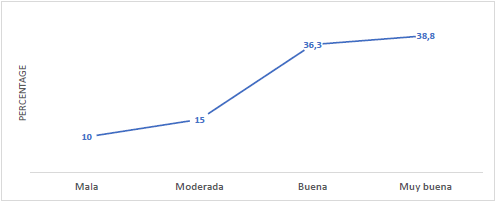
Note. Figure based on table No. 1
Figure 1 Social responsibility perceived by users of the District Municipality of Chilca
The opinions, good and very good, were relevant according to the respondents, they understood that the social responsibility adopted by the municipal district of Chilca is to somehow resolve the needs of the population, in turn this responsibility has been assumed in critical moments, such as of the COVID-19 pandemic. However, there are opinions that are not so favorable because they ignore the effectiveness of the responsibility programs assumed by the Municipality. Social responsibility is understood as the capacity and obligation to respond to society for actions or omissions for the common good, and as it is the behavior of a set of moral behaviors, based on the capacity achieved to reconcile the satisfaction of one's own. needs, and the contribution to satisfying the needs of others, with an important territorial component. (Navarro et al., 2017).
Table No. 2 Dimensions of social responsibility perceived by users of the District Municipality of Chilca
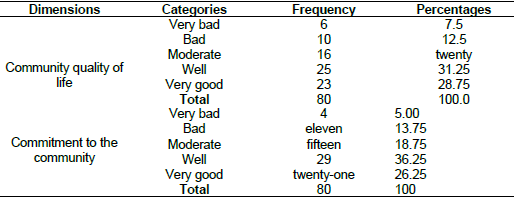
Note. Own elaboration based on the survey applied to the study sample.
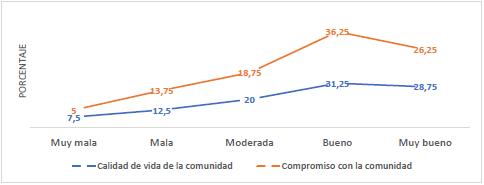
Note. Figure based on table No. 2.
Figure No. 2 Dimensions of social responsibility perceived by users of the District Municipality of Chilca
In the quality of life dimension of the community, the opinions, moderate, good, and very good were notable with 60% acceptability, and 40% were unfavorable opinions, they perceive that the quality of life of a person is linked to the reality that lives, this situation is not abandoned in majority opinion by the municipality, quality of life is an eminently human notion that is related to the degree of satisfaction that the person has with their physical situation, their emotional state, their family life and social, as well as the meaning that he attributes to his life. (Jiménez et al., 2011)
In the community commitment dimension, the good and very good opinions stand out, reaching 63.5% and the very bad, bad and moderate opinions reaching 36.5%. The percentage difference allows us to infer that the different actions carried out by the municipality, when facing to both family and social needs, they do not abandon community care programs. The municipality of Chilca in its concerted development plan (PDC) 2015-2025, contemplates in its objectives, emphasizing the preservation and benefit of the biological variety, strengthening environmental management, promoting the conservation of resources and improving the adaptation to climate change.
Table No. 3 Environmental quality perceived by users of the District Municipality of Chilca

Note. Own elaboration based on the survey applied to the study sample.

Note. Figure based on table No. 3.
Figure 3 Environmental quality perceived by users of the District Municipality of Chilca
Nowadays, the duty of an institution with nature is to ensure compliance with the processes in their internal context, whether due to their characteristics, services, disposal of materials and emissions control, practices to counteract its deterioration. promoting and raising awareness of energy control and recycling criteria (Oltra and Sala, 2015). Given the situation presented, the respondents considered that the quality of the environment as the responsibility of the municipality is good, and very good, with an acceptance of 71%, this is interpreted as the municipality through waste collection programs It has been complying with the established regulations issued by the local government.
Table No. 4 Dimensions of the environmental health variable perceived by users of the District Municipality of Chilca
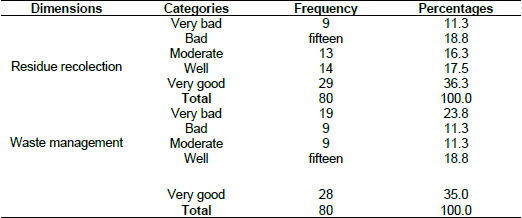
Note. Own elaboration based on the survey applied to the study sample.

Note. Figure based on table No. 4.
Figure No. 4 Dimensions of the environmental health variable perceived by users of the District Municipality of Chilca
In the waste collection dimension, as seen, waste collection is a priority and this function is carried out consecutively, the district municipality of Chilca, through the relevant offices, develops waste classification programs. These actions are perceived by users as good and very good in 53.8%. Solid waste is a serious pollution problem that affects the environment and human life. "For this reason, to optimize energy recovery from waste, an adequate characterization must be had for each of the sources that contribute to this solid waste, such as: household, commercial and agricultural solid waste." (Quillos et all.,2018)
In the waste use dimension, opinions were divided, the percentages of very bad and bad draw attention, because the municipality does not develop management policies to generate small companies that can reuse this waste, however, a slight percentage advantage of citizens who gave their opinion as moderate, good and very good. The use of organic solid waste is seen as an isolated process within the public toilet service. "The treatment of this waste is done in landfills or incinerators that are often located in minority or depressed areas, generating an increase in health and poverty problems." (Castañeda and Rodríguez, 2017)
Inferential study
The objectives were demonstrated with Kendall's tau-b correlation coefficient; for its use they do not require that the sampling distribution fit a known distribution. They are used for variables measured on an ordinal scale. “They are calculated based on a series of assigned ranges” (Sagaró and Zamora, 2020).
Table No. 5 Correlation coefficients of the variables social responsibility and environmental health and dimensions
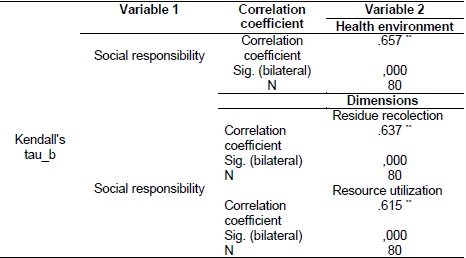
**The correlation is significant at the 0.01 level (two-sided).
Note. Own elaboration based on the survey applied to the study sample.
The formulated objectives were: Determine the relationship that exists between social responsibility and the quality of the environment perceived by users of the district municipality of Chilca - 2020, the correlation coefficient shows τ = 0.657 with bilateral significance of p = 0.000; In light of the result, it was determined that the relationship is moderate. Regarding the relationship between waste collection, the result was τ = 0.637 and regarding the use of solid resources, the coefficient was τ = 0.615, in both cases the bilateral significance was p = 0.000, therefore the relationships with the dimensions are also moderate. The coefficients found reflect that the Municipality is not complying with the responsibility regulations and the quality of the environment as effectively, users perceive that the contributions made to the municipality in different areas are not used effectively.
The hypotheses that were analyzed were tentative responses to the problem, whose statement was: there is a significant relationship, the significance was demonstrated with the coefficients found, demonstrating that p = 0.000 is lower than p < 0.001, this relationship supports rejecting the null hypothesis and accepting the alternative hypothesis.
Table No. 6 Summary of environmental quality correlation coefficients and dimensions
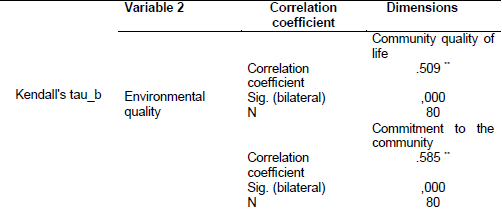
**The correlation is significant at the 0.01 level (two-sided).
Note. Own elaboration based on the survey applied to the study sample.
The specific objectives formulated were: Establish the relationship that exists between the quality of environmental health and the quality of life of the community perceived by users, commitment to the community of the District Municipality of Chilca - 2020. The coefficients found were for quality of life τ =0.509 and depending on commitment to the community τ =0.585; In both cases the bilateral significance was p = 0.000; These values allowed us to establish that the relationship in both cases was moderate. The relationship found confirms that municipal management in these variables and dimensions is moderate in the eyes of the municipality's users. The hypotheses formulated were to demonstrate the significance of the relationship, said significance is admitted, because p = 0.000 is less than p < 0.01, the coefficients found are significant, therefore, the null hypothesis is rejected and the alternative hypothesis is accepted.
DISCUSSION
In this investigation, when determining the relationship that exists between the responsibility social and the quality of environmental health perceived by users of a certain District Municipality, a moderate relationship was found, a not so significant percentage mentioned that the social responsibility assumed by the municipality is good with respect to the health of the environment, however, there is another majority percentage who have an unfavorable opinion of the management carried out by the Municipality.
The results found are similar to Carrión's work. (2019). The objective was to analyze the relationship between business management and social responsibility. Its methodology is descriptive correlational, not experimental cross-sectional. He concluded that the relationship is significant between both variables. The study is not directed based on the municipality, however, it is not far from the research, because social responsibility occurs in all organizations, both private and public, with differences in its application, the correlations in both are for ordinal variables. and the coefficients used are appropriate, they only differ in the sample size that each study adopted.
The derivations of both studies HE contrast with he supposed scientist formulated by Barrio. (2016) where he mentions that, “social responsibility It is the duty, the need that people, part of a population or institution, on a voluntary basis, to encourage the population to be more objective and that help to contrasts ensure by the nature".
Regarding the objective, establishing the relationship between the health of the environment and the quality of life perceived by users, a moderate relationship was found, this shows that users believe that the management of environmental health to treat the quality of life of the community is not so efficient. The finding is similar to the study carried out by Rojas. (2018) where I conclude that the relationship between renewal management and quality of life is positive.
In the objective, establish the relationship between environmental health and perceived community commitment by users, a relationship could be found moderate, the opinion of users shows that the municipality, despite having established regulations, does not implement it as a priority. Our derivation HE resembles to the study done by Frank. (2018) where I conclude that the relationship between environmental education and the conservation of environmental health is significant.
CONCLUSIONS
It is concluded to determine the relationship between social responsibility and environmental health as moderate, in the perception of external users of the district municipality, we deduce that the relationship between the established variables does not show a high relationship but rather a moderate one, the reason is that Attention to the needs of the population to preserve the health of the environment is not significant; likewise, in terms of specific objectives, it is possible to establish the relationship between the quality of the health of the environment and the quality of life of the community; commitment to the community; waste collection and use of waste as moderate. As evidenced by the inferential analysis of the data obtained from the study sample.
The municipality plays a front-line role by acquiring a commitment to social responsibility in maintaining the health of the environment. This management is observed by users and they evaluate said management as moderate, they do not fully comply with the policies issued by the Ministry of the Environment.
According to some approaches, social responsibility is a fundamental tool of municipal management, the population assisted by the municipality benefits from the programs, the ISO 26000 standard mentions that on the topic of social responsibility there is a close relationship between society, organizations and environment. This is why all public and/or private organizations must safeguard the coexistence of citizens in their jurisdiction.
Social responsibility does not consist of mere philanthropy, it is not about carrying out charitable, selfless actions, but rather about designing the company's actions in a way that takes into account the interests of all those affected by it. The idea of benefit is extended to the economic, social and environmental, and that of beneficiary, to those affected by the company's activity. Social responsibility must be assumed as a process, as a management tool, as a measure of prudence and as a demand for justice. (Curtain,2005)
It should be noted that the collection of waste of all types is not carried out regularly, the collectors that the municipality has do not supply the entire population of the district, causing mounds of garbage at street intersections, this situation has an impact on the health of the community. population, nauseating odors are polluting for the population of children and especially for the elderly, in terms of the commitment adopted by the directors of the municipality with the community, promises at election time are not fulfilled, therefore it generates discomfort in the population.
Waste collection is diminished by the poor management of the authorities, environmental education campaigns are almost not carried out, there are established organizations such as the neighborhood council, mothers' clubs with whom agreements must be established to develop environmental education programs, the managers They must promote strategies for the use of waste, classifying them into organic and inorganic waste, creating communal companies for the manufacture of guano, which would generate economic income for the needy population.
Despite these difficulties observed by users, the majority think that not everything is bad, they recognize the effort that the municipality has to comply with the management of social responsibility in the care and health of the environment.
Based on the results obtained, referring to the management of the municipal district government, we suggest that the researchers delve deeper into the topic, because the work contributes to the municipal government, the need to prioritize the solution of the problems analyzed, thus improving health. environment of the inhabitants of the district area.














